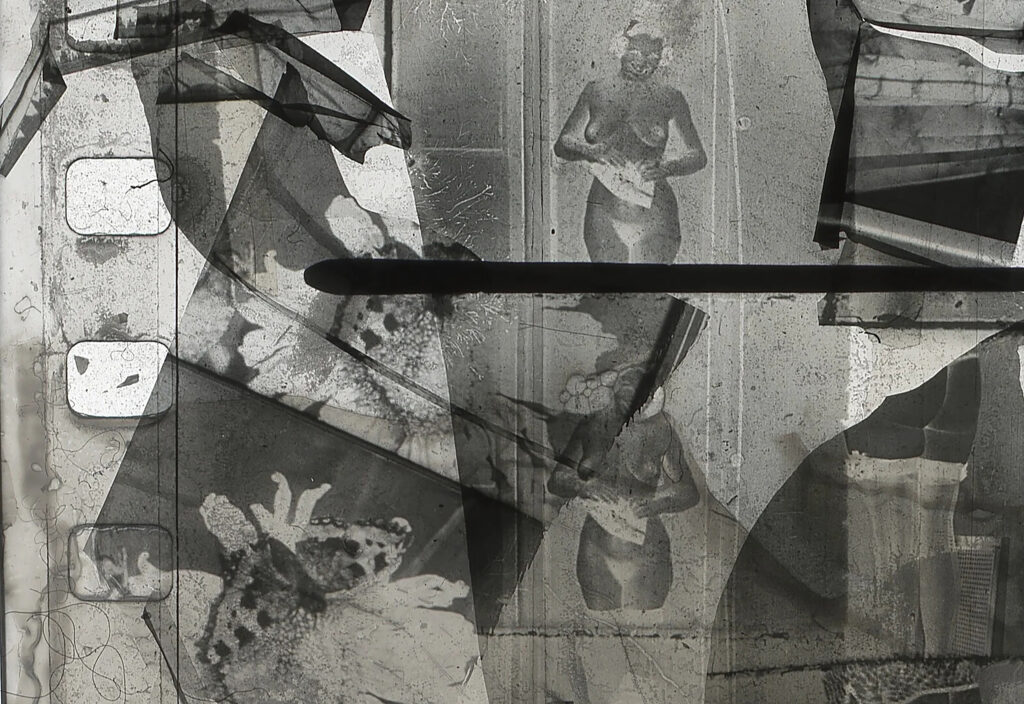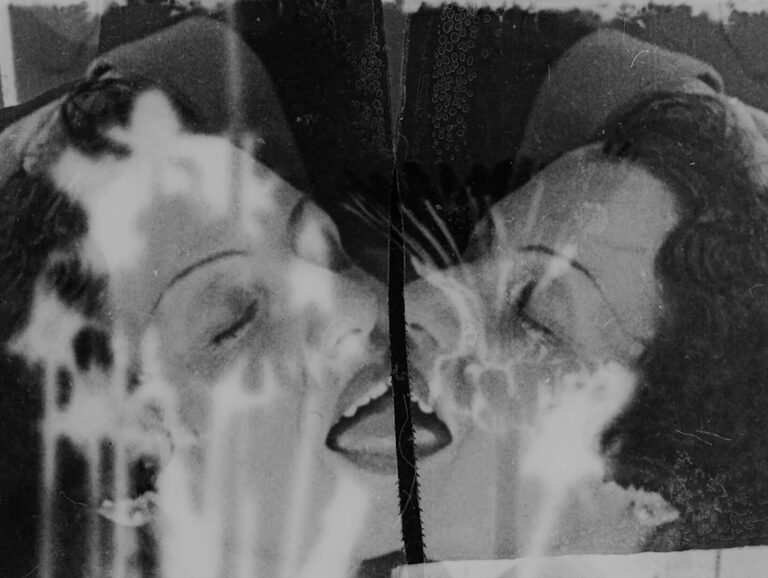Below is an interview with director Federica Foglia about her Negative/Positive Film.
What kind of work have you done on archive materials for your film?
I treat these found images with a technique known as Emulsion Lifting, which is the process by which photographic emulsion is lifted off the polyester base by hand and then placed back on another base. It is a process analogous to collage, working in layers with a very fragile material. Each individual strip of film is “peeled off” by hand, resulting in a small, shapeless, gelatinous mass, the image is still there…imprinted in the gelatin, only after being peeled off…it remains in my hands liquefied. From there I begin to flatten it back onto the base of another film, tapping gently so as not to destroy the fragile material. Besides being very delicate, 16mm is also a very small format to handle. The closest thing I can think of – is the process that tissue paper goes through when it is glued with vinyl glue, one wrong step and it might tear, or stick badly. I try to create overlapping layers of this emulsion (tissue paper) to produce handmade overlays, I like to form visual juxtapositions, it helps me understand the world better.
Of course, it would be much easier to create the overlays through a post-production program, creating a multi-layered image digitally. Surely it would be faster, to create one second of film, that is 24 frames, I often take 2 to 3 hours, as for animation.
It is no coincidence that this type of work is often called direct-on-film-animation/direct animation on film.
Although I am aware of the possibility of being able to create these overlays digitally, for me the tactile, handcrafted approach to the image is fundamental. Working with my hands, on living matter, is a process analogous to sculpture. It allows me to think about the image with my hands and not with my eyes. It is a type of work that prefers the tactile sense to the visual sense. I feel very much akin to those who work on homemade decoupage or even crochet work.
In the film, as well as in your entire film production, the ephemeral has a strong aesthetic and symbolic value. Can you tell us more about what significance archival footage, which by nature is so fragile, has for you?
As I mentioned earlier, for years now I have adopted a materialist methodology of working that leads me to work directly on the surface of these recycled, discarded films destined for oblivion. So-called orphan films, because they have now lost all connection with their original creator. I collect these kinds of stray scraps because I feel a bit like that myself, looking for a home. I try to place them back on the screen from which they were temporarily ousted. Films on the margins to which I try to reassign a predominant position.
Archival images, especially those without a clear provenance, contain within them the iconic power of poetry. They are fragments of truth’ disconnected from their original context, and it is in this disconnected nature that their power lies. By digging, fragment by fragment, I try to assemble these images often not belonging to the same film, associate them, create new meanings, revive them.
I look at the archive as a collaborative and constantly moving space. Not a static, dogmatic, inaccessible archive but a fluid, becoming and re-becoming archive. An archive in which past and present do not exist in a linear, unidirectional or chronological temporality but rather circular, timeless and omni-directional. The past and the future on a continuous loop line, passing through the future returning to the past in a constant circle, where at each step a new meaning arises from the archived and de-archived images.
In this sense I feel very close to Ariella Azoulay who defines the archive not as a place but as a threshold. An always open door that promotes a participatory approach between citizens, artists and institutions in the process of archiving and de-archiving.
No longer an armored archive where historical memory is entrusted to a few, but a point of contact and encounter.
What found footage and/or experimental film titles were important to your education?
Definitely all the films of Cécile Fontaine (especially Japon Series), a brilliant French director to whom I owe a lot, she was one of the first directors I found when I started my research on the Emulsion Lifting technique. After I came across her films I thought that after all what I was trying to do with celluloid was not so absurd and that this director before me had succeeded… Although we have never met, I hope one day to be able to compare myself with her.
Then there is the brilliant Vivian Ostrovsky, her U.S.S.A. is a masterpiece, although my style differs from hers (at the moment) I found in her approach to editing an inexhaustible source of inspiration. Abigail Child with The Future is Behind You left me astounded, using found-footage dating back to 1930 she created such an intricate yet honest and intimate film and montage from otherwise anonymous archival material. My artistic practice owes a lot to these women directors, looking at their filmography I feel encouraged, legitimized, I realize that you can make this kind of cinema. Then Gariné Torossian, and her beautiful Girl from Moush to which I often return, Frédérique Dévaux Exile Series, Tina Takemoto, Carolee Schneemann, Louise Borque L’Eclat du Mal to which I feel particularly connected on an aesthetic level. I could go on and on!

